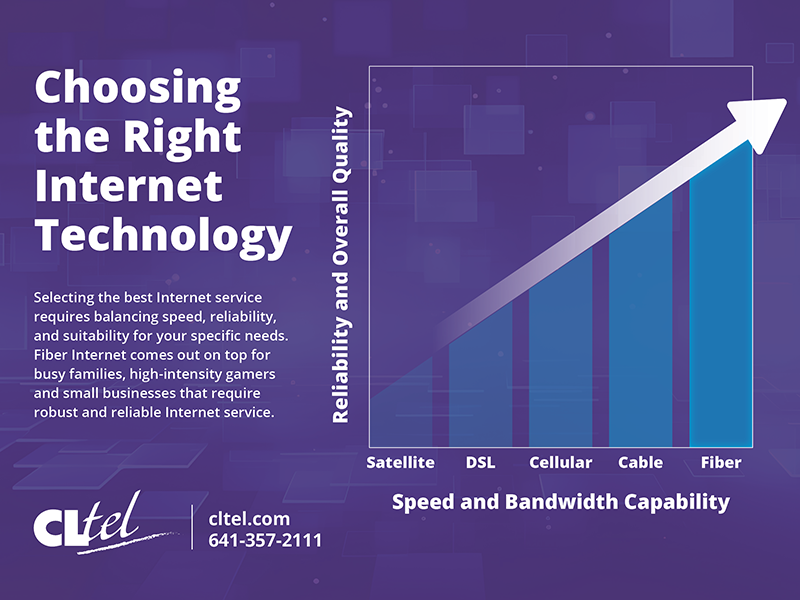With nine in ten U.S. adults saying they go online daily, selecting an Internet provider is more than a technical decision. It’s about finding a provider that understands how you use the Internet. Imagine having an Internet connection that meets your needs and empowers you to connect, create, and communicate. Effortlessly. Whether managing a bustling household of young Lions, running a business on Main Street, or immersing yourself in the latest online game, the right Internet technology will transform your daily experience.
Our goal is to help you navigate this important choice with confidence and clarity. We break down the pros and cons of different Internet technologies, offering insights to guide you toward the best option for your unique situation. We’ve also included a quadrant matrix to visualize the performance and suitability of each technology so you can make an informed decision that enhances your online life.
Let’s explore these options together and find the Internet service that truly fits your world.
The Best Choice: Fiber Internet

Fiber Internet stands out as the top choice, positioned firmly in the upper right quadrant of our matrix.
- Speed and Bandwidth: Fiber Internet provides the fastest speeds available, making it ideal for high-intensity online activities such as gaming, streaming, and handling multiple devices simultaneously.
- Reliability: Fiber Internet is known for its reliability. It experiences minimal downtime and maintains consistent speeds regardless of usage levels.
- Future-Proof: Fiber is a long-term investment in your digital experience, capable of meeting the demands of future technologies.
Best value for everyone, especially for busy families, high-intensity gamers, and small businesses that require robust and reliable Internet service.
A Distant Second: Cable Internet
Cable Internet offers a decent balance of speed and performance, placing it in the bottom right quadrant. While it doesn’t match fiber optic, it can be an adequate option.
- Speed: Cable Internet provides high speeds, which are suitable for families with multiple devices, light gaming, and work-from-home use.
- Performance: Speeds can be inconsistent due to shared bandwidth with neighbors, particularly during peak times.
Best for families and individuals who need Internet for everyday use and can live with occasional speed fluctuations.
Mobile and Flexible: Cellular Internet
Cellular Internet occupies the middle quadrant due to its variable performance but excellent mobility.
- Flexibility: Cellular Internet is ideal for on-the-go use, and it is perfect if you need Internet access while traveling down I-35 or in areas without fixed-line infrastructure.
- Performance: Speeds can vary based on signal strength and network congestion. 4G/5G networks offer acceptable speeds, but data caps and higher latency can be limitations.
Best for individuals or small families who need flexible Internet access and can manage with variable speeds and potential data limits.
The Basic Option: DSL Internet
DSL Internet falls into the lower left quadrant due to its lower speeds and performance.
- Availability: DSL is widely available and affordable. It uses existing telephone lines, making it accessible even in many rural areas.
- Performance: However, it’s an older technology with limited capability to meet modern demands, resulting in slower speeds and lower overall quality.
Best for individuals or small families with limited Internet needs and those looking for a budget-friendly option.
The Rural Solution: Satellite Internet
Satellite Internet is also in the lower left quadrant, primarily serving rural and remote areas with limited options.
- Availability: Satellite Internet can reach locations where terrestrial Internet services cannot, making it a vital solution for rural residents.
- Performance: However, it comes with high latency, lower speeds, and potential performance issues during adverse weather conditions.
Best for rural residents who have no other viable Internet options and can tolerate higher latency and weather-dependent performance.
What’s Right for You
Choosing superior Internet service involves balancing speed, reliability, and suitability for your specific needs. Our quadrant matrix highlights Fiber Internet as the top choice for those seeking the best overall performance. However, each technology has its strengths and ideal use cases. Whether you opt for fiber optic, cable, cellular, DSL, or satellite, understanding these factors will help you make an informed decision that enhances your online experience.
For more information and to explore the best Internet options for your home or business, visit the CLTel website or call 641-357-2111.



